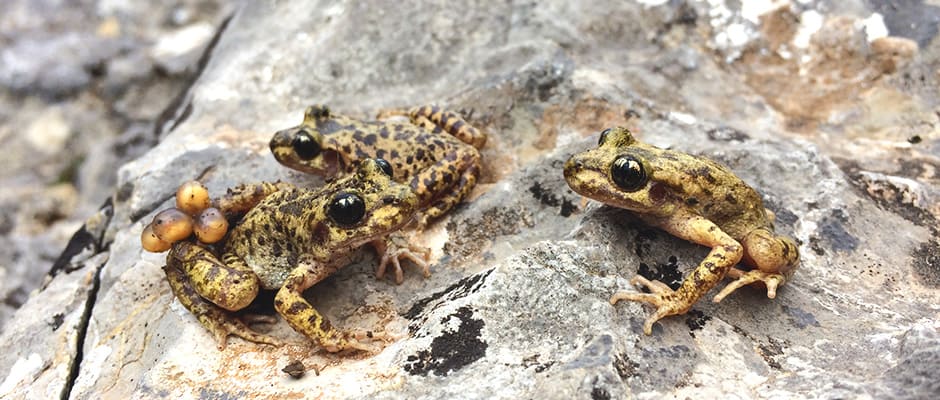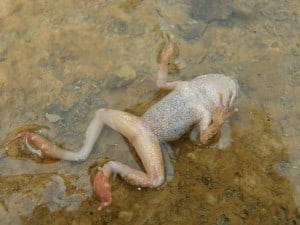Share this article
Researchers Find Potential Cure for Deadly Amphibian Fungus
A potential cure for the deadly disease wiping out vast populations of amphibians all came down to special two-liter coke bottles filled with water and tadpoles from an island off the Mediterranean coast of Spain.
Researchers like Trent Garner and Jaime Bosch spent days hiking in and out of remote mountains — the latter even rappelling down cliffs into canyons — to reach small ponds full of tadpoles of the Mallorcan midwife toad (Alytes muletensis).
“Sometimes we’d have to sleep on the stones and hike out in the morning,” said Garner, a professor at the Zoological Society of London’s Institute of Zoology and senior author of a new study published in Biology Letters.
The researchers would place the tadpoles in the coke bottles equipped with pumps that kept the water oxygenated for the young amphibians and transported them to a lab. They were also careful to keep the bottles from heating up too much along the way.
“If it got too hot you had tadpole soup, and if they didn’t have enough oxygen they’d die,” Garner said.
Once there, they applied a fungicide individually to each tadpole and monitored their recovery.
Living Fossil of the Mediterranean
The toad has had a somewhat tumultuous history over the past few decades. It was formerly thought to be extinct — the amphibian had only been described to science through the fossil record — but live populations were discovered in the 1980s on Mallorca, leading to the toad’s moniker as “a living fossil.”
A few years after discovery, researchers found that five of the 30 breeding ponds of the toad on the island were infected with the deadly chytrid fungus — also a relatively new discovery — potentially through close contact with imported African frogs in captive facilities where researchers were working on bolstering populations.
But researchers had already discovered chytrid relatively early in the more widespread related species the common midwife (Alytes obstetricans), found in parts of mainland Spain and other European countries. Tests showed that using the fungicide Itraconazole seemed to clear the chytrid from common midwife toads without doing harm to the species.
With that knowledge, researchers set out to capture Mallorcan midwife tadpoles from remote, infected pond areas and bring them back to the laboratory where they applied the fungicide. After removing the tadpoles they had also cleared the water from the ponds, measuring roughly 6.5 feet in diameter, by using buckets and bailing it out in an effort to rid the areas of traces of the deadly fungus.
But there was a problem. Although the amphibians were cleared of the fungus at the time they were returned to the pond, many of them were reinfected as the chytrid seemed to persist in the ponds where they were released.
“We kept getting reinfection at this one drainage,” Garner said.
So they tried something else. Garner said that researchers working with amphibians and chytrid often used Virkon, a common lab disinfectant, on their boots when moving between ponds and at some point tests were done to make sure there were no adverse effects of this chemical on the toads.
Garner and the others went back into the pond areas and applied this disinfectant to the water and it worked — the chytrid fungus is currently clear from four of the five infected ponds and the researchers are on the cusp of success with the remaining pond.
“The first and most important thing about this is it shows that this can be done,” Garner said of the elimination of chytrid in a wild amphibian population. But he’s cautious of saying this is the end-all solution for eliminating chytrid fungus in various places, since different environments have different ecosystem challenges. In this study, researchers personally applied the fungicide to individual tadpoles.
“I would imagine in some situations it’s going to be really difficult to apply these methods,” said Garner, adding that they still have to do post-exposure study impacts of the ponds.
But there may be ways to apply in and the disinfectant more broadly.
“The two concepts together are not particularly unusual, which suggests that this could have potentially broad applications,” he said. “It’s down to the local research practitioners to figure out what chemicals to use and how they can use them in a way that’s appropriate for those systems.
He said this success can hopefully motivate others to be successful in the fight against chytrid fungus.
“This paper is a win and what we’re hoping is it can inspire both researchers and funders to get behind infectious diseases as issues.”
Header Image: Mallorcan midwife toad. Image Credit: Jaime Bosch MNCN-CSIC









